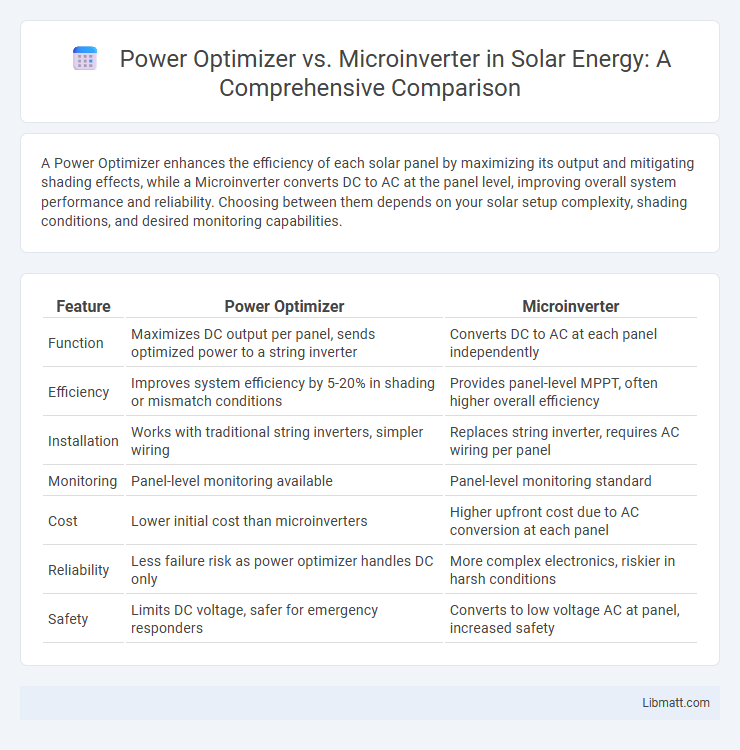A Power Optimizer enhances the efficiency of each solar panel by maximizing its output and mitigating shading effects, while a Microinverter converts DC to AC at the panel level, improving overall system performance and reliability. Choosing between them depends on your solar setup complexity, shading conditions, and desired monitoring capabilities.
Table of Comparison
| Feature | Power Optimizer | Microinverter |
|---|---|---|
| Function | Maximizes DC output per panel, sends optimized power to a string inverter | Converts DC to AC at each panel independently |
| Efficiency | Improves system efficiency by 5-20% in shading or mismatch conditions | Provides panel-level MPPT, often higher overall efficiency |
| Installation | Works with traditional string inverters, simpler wiring | Replaces string inverter, requires AC wiring per panel |
| Monitoring | Panel-level monitoring available | Panel-level monitoring standard |
| Cost | Lower initial cost than microinverters | Higher upfront cost due to AC conversion at each panel |
| Reliability | Less failure risk as power optimizer handles DC only | More complex electronics, riskier in harsh conditions |
| Safety | Limits DC voltage, safer for emergency responders | Converts to low voltage AC at panel, increased safety |
Introduction to Solar Power Optimization Technologies
Power optimizers and microinverters are advanced solar power optimization technologies designed to enhance energy harvest and system efficiency. Power optimizers are module-level DC/DC converters that maximize output by reducing losses due to shading or panel mismatch, while microinverters convert DC to AC at each solar panel, enabling independent operation and monitoring. Both technologies improve overall solar system reliability and performance compared to traditional string inverters by addressing panel-level issues effectively.
What is a Power Optimizer?
A Power Optimizer is a device installed on each solar panel to maximize energy output by performing panel-level Maximum Power Point Tracking (MPPT), improving overall system efficiency. Unlike microinverters, which convert DC to AC at the panel level, power optimizers work alongside a central inverter to optimize power before conversion. Your solar power system benefits from reduced shading impact and enhanced monitoring capabilities with power optimizers.
What is a Microinverter?
A microinverter is a device installed on each solar panel in a photovoltaic system, converting direct current (DC) generated by the panel into alternating current (AC) for use in your home or grid. Unlike traditional string inverters, microinverters optimize the power output individually for each panel, improving overall system efficiency and minimizing the impact of shading or panel mismatch. This technology enhances energy harvest, system monitoring, and reliability, making it a popular choice for residential solar installations.
Key Differences Between Power Optimizers and Microinverters
Power optimizers and microinverters both enhance solar energy system performance by maximizing individual panel output, but power optimizers condition DC power before sending it to a central inverter, whereas microinverters convert DC to AC at each panel. Key differences include system design complexity, with microinverters simplifying installation by eliminating the need for a separate inverter, while power optimizers require a compatible string inverter. You should consider factors like shading impact, monitoring capabilities, and cost when choosing between these technologies to optimize your solar energy system efficiency.
Efficiency and Performance Comparison
Power Optimizers enhance your solar energy system's efficiency by maximizing the output of each individual panel, reducing losses caused by shading or panel mismatch. Microinverters convert DC to AC at the panel level, improving overall system performance and providing detailed monitoring for each module. Both technologies improve energy harvest, but power optimizers are preferred for optimizing panel-level power conversion while microinverters excel in enhancing conversion quality and panel-level diagnostics.
Installation Complexity and Costs
Power optimizers require fewer direct connections to each solar panel, simplifying system wiring and reducing installation time, which can lower labor costs compared to microinverters that must be installed on every panel individually. Microinverters, while increasing hardware costs due to one unit per panel, provide easier troubleshooting and panel-level monitoring, possibly reducing long-term maintenance expenses. Overall, power optimizers present a more cost-effective installation option for large-scale systems, whereas microinverters involve higher upfront investment but offer installation simplicity on a panel-by-panel basis.
System Monitoring and Maintenance
Power optimizers provide module-level monitoring that enables precise detection of performance issues, allowing for efficient and targeted maintenance. Microinverters also offer individual panel monitoring, simplifying troubleshooting by isolating underperforming units quickly. Both technologies enhance system reliability by facilitating timely interventions and minimizing downtime.
Scalability and Flexibility for Solar Arrays
Power Optimizers enhance scalability by allowing individual solar panels to operate efficiently within larger arrays, optimizing energy output despite shading or panel mismatch. Microinverters provide greater flexibility with independent AC conversion at each panel, simplifying system expansion and maintenance without the need for central inverters. Your solar array's scalability and adaptability improve significantly by choosing between these technologies based on your system's size and future growth plans.
Ideal Use Cases for Power Optimizers vs Microinverters
Power optimizers are ideal for residential solar systems with shading issues or complex roof layouts, as they maximize energy output from individual panels while reducing mismatch losses. Microinverters suit installations requiring panel-level monitoring and rapid fault detection, especially in smaller arrays or roofs with multiple orientations. Your choice depends on the specific site conditions, system size, and maintenance preferences for optimal solar performance.
Conclusion: Choosing the Right Solution for Your Solar Needs
Power optimizers enhance the efficiency of each solar panel by maximizing energy harvest and mitigating mismatch losses, while microinverters convert DC to AC at the panel level, offering improved monitoring and system resilience. Your choice depends on factors like system size, shading conditions, and budget constraints, with power optimizers often favored for string inverter setups and microinverters preferred in complex or shaded installations. Evaluating your specific solar needs and site conditions ensures optimal energy production and long-term performance.
Power Optimizer vs Microinverter Infographic

 libmatt.com
libmatt.com